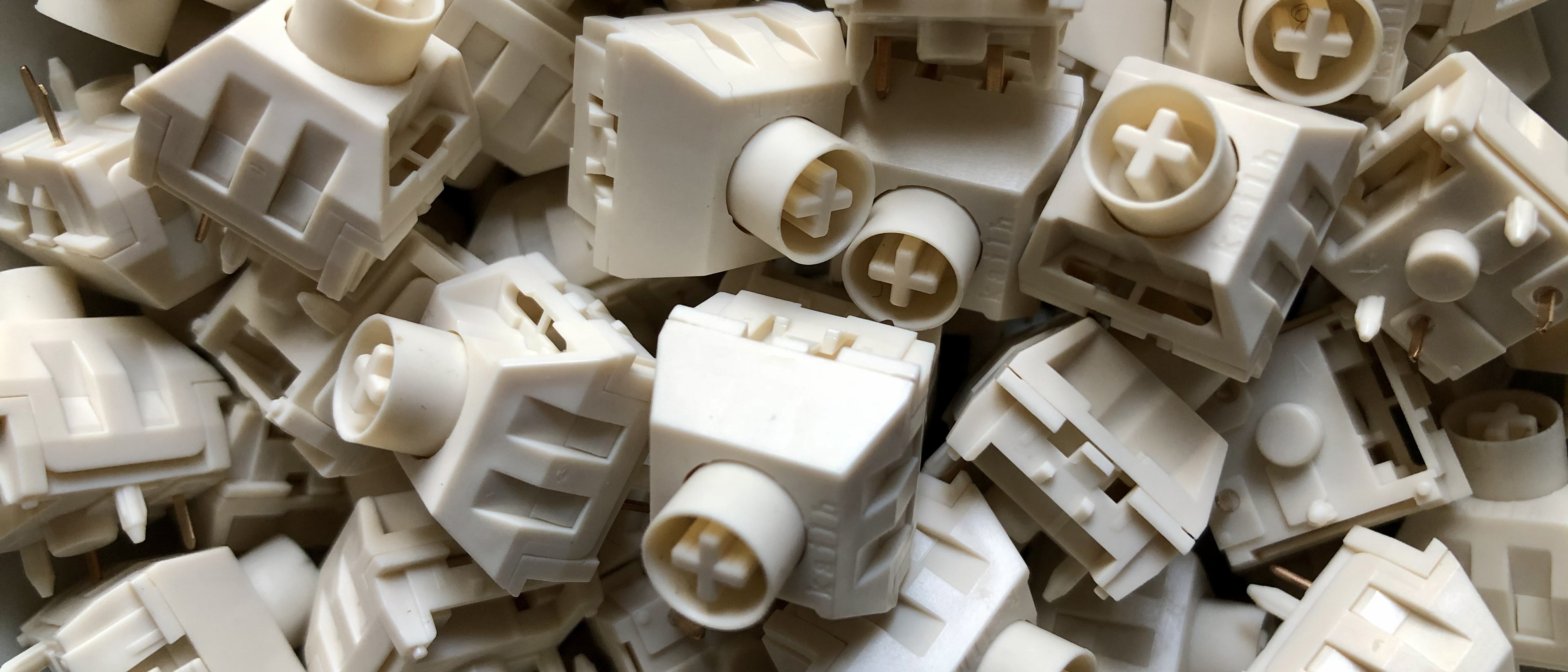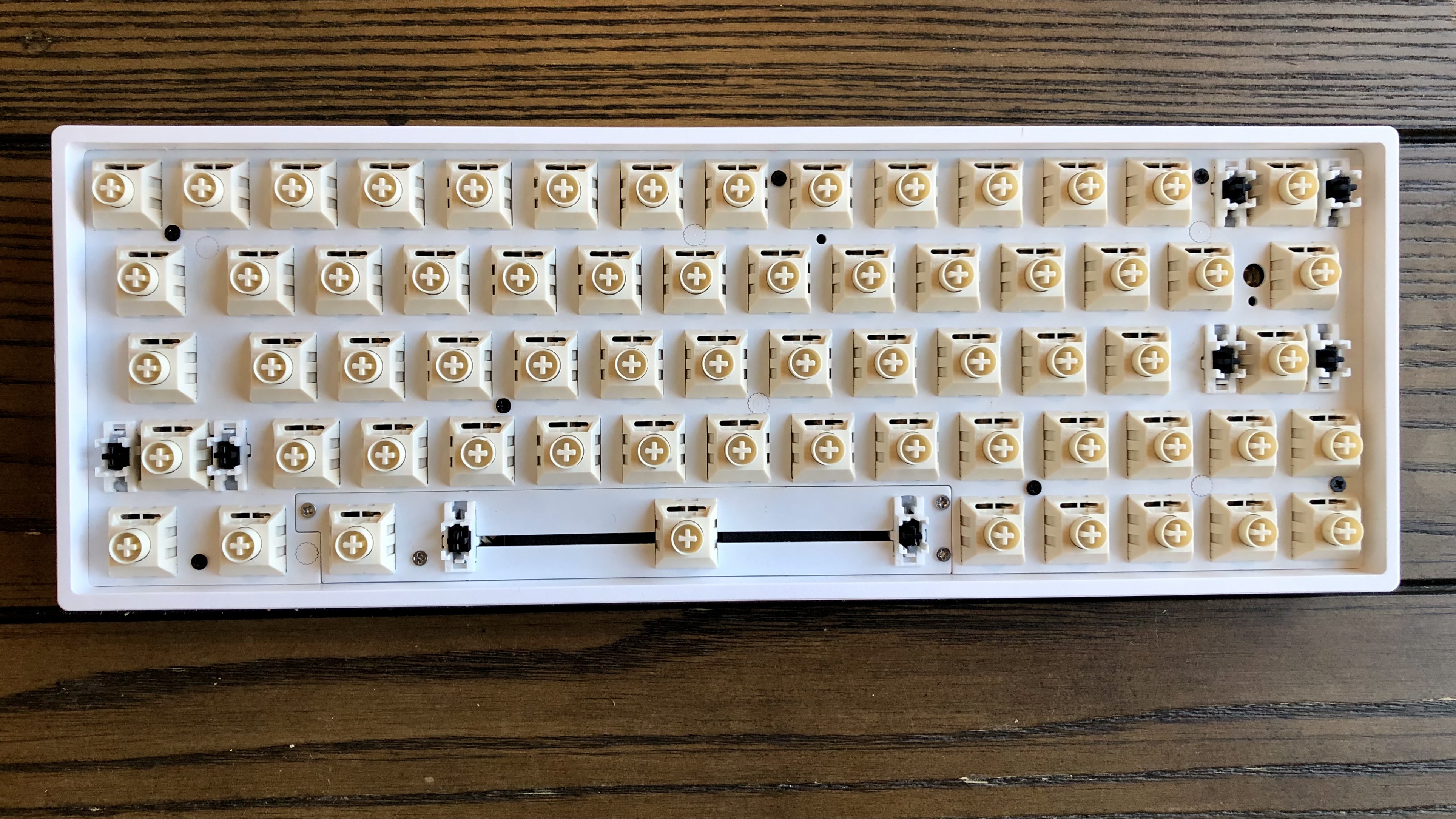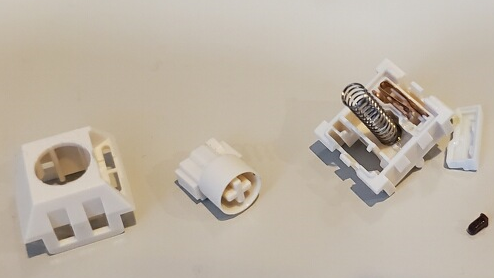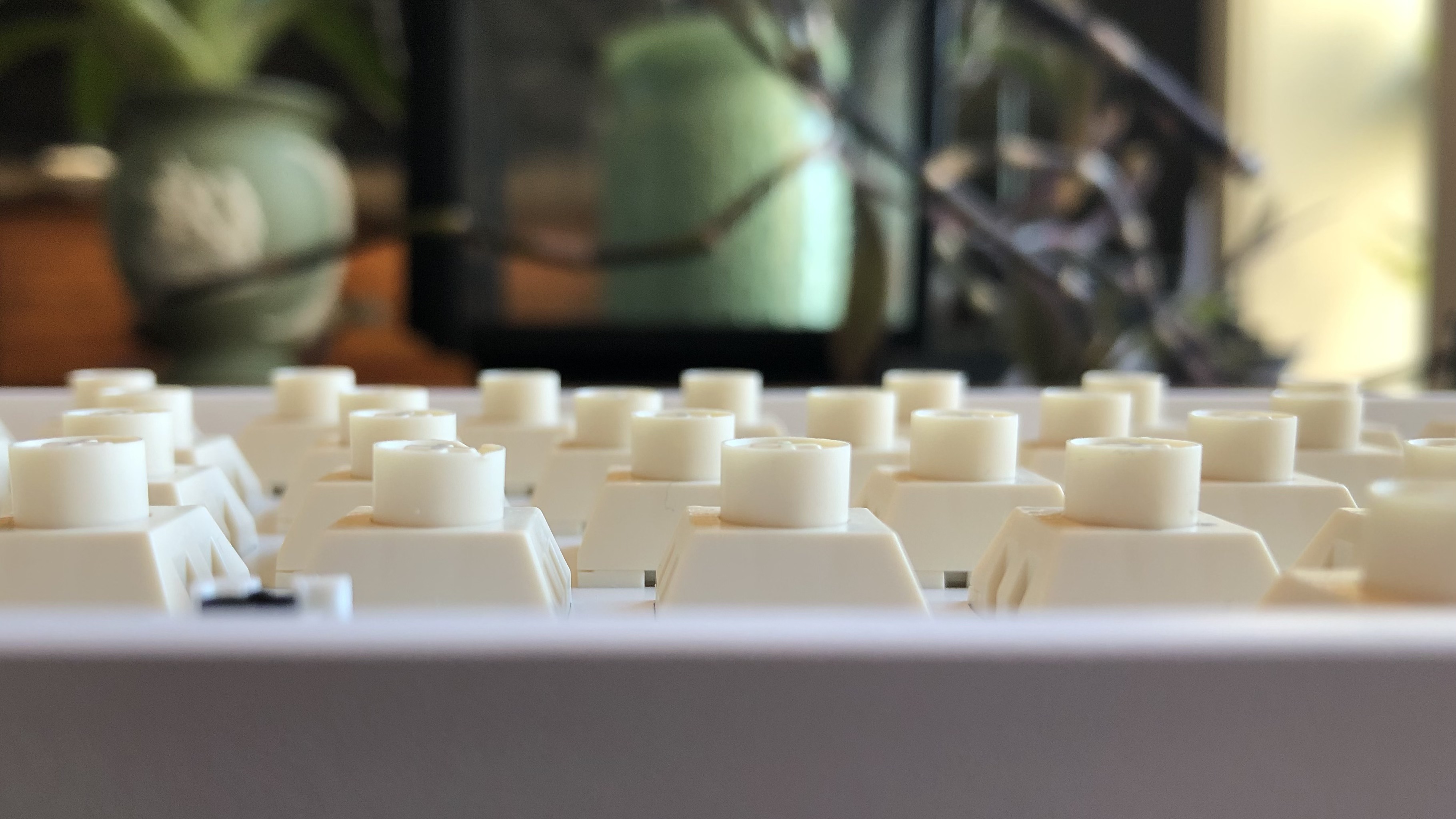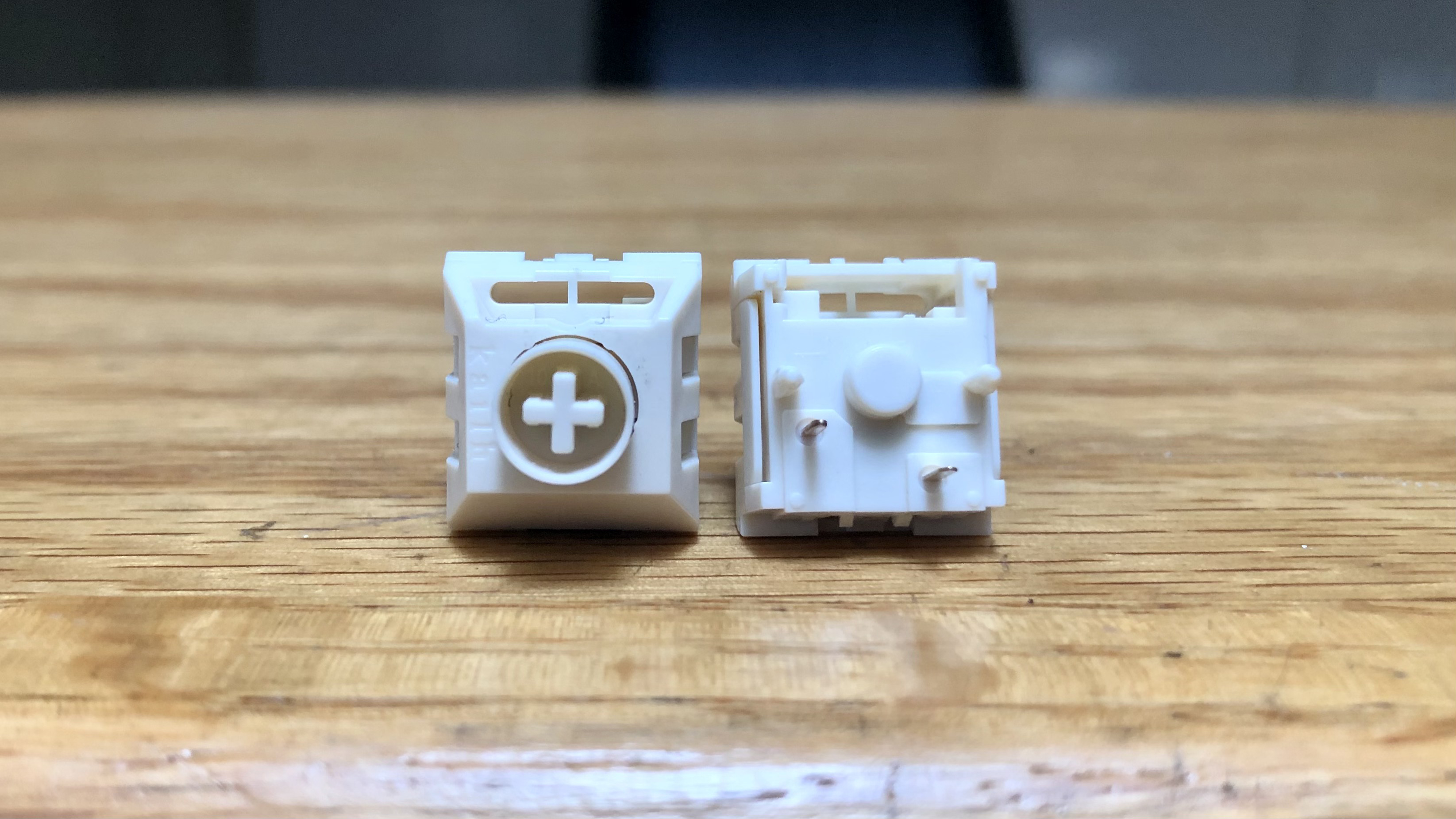Tom's Hardware Verdict
Kailh’s Box Cream mechanical switches offer a familiar linear experience with a softer, more subdued noise than Cherry MX Reds. But there are linear switches with the same specs that feel easier to press.
Pros
- +
+ Pleasant sound
- +
+ Less stiff than other linear switches
- +
+ 5-pin stability
- +
+ Dust, water resistant
Cons
- -
Could be smoother
- -
Expensive
- -
Feels less durable than competitors
- -
5-pin design limits compatibility
Why you can trust Tom's Hardware
All linear mechanical switches depress without any tactility along the way. This makes them a great choice for the best gaming keyboards and anyone who’d prefer a smooth keypress over a tactile bump. Linear travel is nothing new, but there’s a difference between a switch pressing down without interruption and going down smoothly.
Kailh x NovelKeys Box Cream mechanical switches are new this year and a collaboration between the brands, with NovelKeys sharing tooling costs, I’m told. If you’re thinking you’ve seen Kailh Cream switches before this year, you’re not wrong. There were already Kailh x NovelKeys Cream switches, but notice that our review focuses on the Box version, which not only has a different stem style but different specs too.
The Box Cream switch’s creamy beige color is enough to explain the name, but the switch takes an extra step. With the help of a nearly all-POM construction, Kailh describes these switches as self-lubricating. That might make you think each press is more creamy-smooth than rivals, but Kailh Box Cream doesn’t always rise to the top.
Kailh x NovelKeys Box Cream Specs
| Header Cell - Column 0 | Kailh x NovelKeys Box Cream | Kailh x NovelKeys Cream | Cherry MX Red | Kailh Box Red |
|---|---|---|---|---|
| Type | Linear, mechanical | Linear, mechanical | Linear, mechanical | Linear, mechanical |
| Mount | 5-pin PCB | 5-pin PCB | 3-pin plate | 3-pin plate |
| Total Travel | 4mm (± 0.3mm) | 4mm | 4mm | 3.6mm (±0.3mm) |
| Actuation Point | 2mm (±0.5mm) | 2mm | 2mm | 1.8mm (±0.3mm) |
| Actuation Force | 45g (±10g) | 55g | 45g | 45g (±10g) |
| Bottom Out | 60g | 70g | 60g | 60g |
| Lifespan | 20 million presses | Not shared | 100 million presses | 80 million presses |
| Rating | IP52 | N/A | IP40 | IP56 |
Design of Kailh Box Cream Switches
Before buying Kailh Box Creams for your next keyboard build or hot-swappable keyboard, note that these are 5-pin, also known as PCB-mounted, switches, rather than 3-pin, or plate-mounted, switches. While 5-pin switches aren’t uncommon to keyboard enthusiasts, this does affect compatibility. You should ensure that whatever keyboard kit or hot-swappable keyboard you use supports 5-pin switches; otherwise you’ll have to spend time technically damaging the switches to remove the excess pins. Hot-swappable keyboards make it easy to change mechanical keyboard switches, but many, including the Glorious GMMK and Redragon K580 Vata, won’t work with Box Creams out of the box.
5-pin switches mount directly to the keyboard’s PCB instead of the plate on top of the PCB. They have the same two metal pins and large plastic knob in the bottom-center that 3-pin switches have but add two plastic pins for extra stability.
Unlike 3-pin switches, 5-pin switches don’t require your keyboard to have a metal plate on top of the PCB. Instead of mourning to a top plate, like 3-pin switches, these mount to the PCB; however, you may like having a top plate for extra durability or because you’re a heavy typist worried about switch wobble. On the other hand, your keyboard should be easier to build without requiring a plate.
Unlike Kailh Silent Box Red switches, which are unmistakably pink, there’s almost no confusion about how the Box Cream switch got its name. I say almost because people may wonder about the Box branding, since the stem is in a circle housing rather than in a square, (like the design of many other Kailh Box-branded switches ). But the Box name actually refers to the switch’s box-shaped housing, which is in that shape to resist dust and water.
Get Tom's Hardware's best news and in-depth reviews, straight to your inbox.
Additionally, Box Cream switches are IP52-certified, which allows for dust ingress but not enough to prevent satisfactory use and means the switches shouldn’t be damaged by dripping water, even if it’s tilted at up to 15 degrees. This certification is above what many, like Cherry MX Reds, provide and should bring extra confidence to those who travel or switch/store their mechanical switches a lot. After about 1.5 months storing and using the switches, they all still seem functioning, despite me seeing dust sitting on the base of some of the switches after storing and dust on my keyboard’s backplate.
When looking at a Box Cream switch, what stands out most besides its eponymous color is the circle surrounding the familiar, Cherry MX-style crosstem. It’s the same style stem found in Kailh’s Silent Box Red and Silent Box Brown switches. Kailh doesn’t market the Box Creams as being extra-quiet, but as you’ll find out in the next section, they offer a softer noise than other linear rivals.
The crosstem means the Box Creams are compatible with any keycaps that work with Cherry ones (that’s a lot). I was able to use them with HyperX doubleshot PBT pudding keycaps, Razer doubleshot PBT ones, Glorious ABS doubleshot caps and some cheap ABS keycaps I had lying around without incident.
Box Creams’ upper and bottom housing, stem and slider are all made from POM plastic that Kailh describes as self-lubricating. A rep told us that this is a characteristic of POM, but don’t think of it as having an equal effect as buying a lube product and applying it to the switches. According to Hackaday, POM has a naturally high lubricity, but these switches aren’t actively applying new lubrication to itself. As the engineering enthusiast website says, POM “simply has a high abrasion resistance and a very low coefficient of friction, making it appear to be self-lubricating.” Of course, these switches can benefit from your own lubing too.
Such a POM-heavy switch isn’t common. Cherry MX Reds use a CAD plastic polymer upper housing, glass fiber bottom housing and a plastic polymer stem and slider. Kailh’s own SIlent Box Reds have a PA66 upper and bottom housing and POM slider and stem. In terms of how the different materials feel in-hand and during installation and removal, the Box Creams feel slimier, and the northern parts seemed less strong than that part of Cherry MX Reds and more susceptible to giving and, potentially, breaking.
Box Creams also have a different crosspoint contact design than Cherry Reds. The latter’s boast use of triangular cross-contacts and, for fighting corrosion, gold plating. Box Creams have composite gold crosspoints living in a compartment within the switch’s bottom housing for protection against dust and water.
Typing Experience on Kailh Box Cream Switches
The Cream switches have 4mm total travel, actuating at 2mm with 45g of force, bottoming out with 60g. The specs are virtually identical to those of Cherry Reds.
You could remove the pins from a 5-pin switch to make it fit in a keyboard that only accommodates 3-pin one, but to keep things simple I installed the Box Creams in a Skyloong GK64x kit because it’s not too expensive and supports 5-pin switches while including a plate for extra stability. We topped them with Glorious’ doubleshot ABS plastic keycaps, representing a step above standard ABS keycaps but not as premium as PBT plastic.
In a side-by-side comparison between Kailh Box Creams and Cherry MX Reds, the most immediate difference was in the sound. Linear switches are generally quiet, especially when compared to the clicky nagging melody of alternatives, like Cherry MX Blues. But linear switches still typically make a sound when bottoming out and coming back up. The overall sound the Red switches make sounds slightly higher pitched, reminding me of their plastic nature.
The Kailh Box Creams also seemed more stable. The 5-pin switches’ keycaps showed noticeably less wobble in the same keyboard when I moved them intentionally. Although, I was still able to move them if I tried.
Kailh Box Creams adhere to their linear roots, providing smooth travel from the start of the press through the full 4mm of travel. But the very finicky may notice a slightly tactile feel when hitting keys, especially larger ones, from a side angle. This seemed more prominent when typing aggressively. It sort of feels like a very minor pop when coming back up. This wasn’t enough to upset me or interrupt my productivity, but I did notice it. If you type less aggressively than me (I’m usually bottoming out), your experience may vary.
But what makes this behavior extra disappointing is the so-called self-lubrication the Kailh Box Creams are supposed to have. While the use of POM may be aiding the overall feel and sound of Box Creams, they didn’t immediately feel smoother to press than Cherry Reds. They only, perhaps, had a more hollow-feeling. And we’ve felt switches with above-average smoothness before. The Varmilo EC Sakura V2 switches available in the Varmilo MA108M Moonlight are an example, making typing feel more effortless, quicker and slicker, despite having the same specs as Box Creams.
After a lot of time comparing Box Creams and Cherry Reds though, it became apparent that the Cherry Reds could feel more stiff when rapidly typing. For those who spend a lot of their day typing , this could be advantageous. But the difference was so minor that it took a lot of comparing to notice, and the EC Sakura V2s still out-smoothed the Box Creams.
I did enjoy typing on Box Creams more than Cherry Reds. For the record, I’d prefer typing on a tactile or clicky switch, so the accidental sense of tactility wasn’t an issue for me and, actually, closer toward my personal preference. The occasional variation in feel wasn’t too distracting. The more pleasant sound also made me more eager to type than Cherry Reds, which now sounds like someone lightly tapping their nails on a desk in comparison. And on the 10fastfingers.com typing test, I was able to hit my typical average speed and accuracy, despite my slight aversion to linear typing.
Gaming Experience on Kailh Box Cream Switches
As a linear switch, the Box Creams are a good consideration for gaming. Because there’s no tactile bump, I found it easy to press keys repeatedly and rapidly. I also happen to like the sound of these switches better than that of other linear switches. That means less distraction on the battlefield, albeit not as little distraction as something like a Silent Box Red or MX Red Silent would provide.
Very competitive gamers or those who want the smoothest linear switches may be left wanting. Key binding could be a distraction for such gamers, but most won’t find the issue severe enough to result in significant delays or mis-fires.
I didn’t feel any obvious advantage in using these for gaming compared to the current linear standard, Cherry MX Reds. Although Cherry Reds sometimes felt stiffer when typing rapidly, this was less apparent in-game. And in a non-scientific test I was able to press a key with a Box Cream switch about the same number of times in a limited time period as the same key with a Cherry Red switch. Both are also comparably easy to press halfway and/or actuate again without bottoming out; although the stability of the Box Creams make this slightly more natural.
Price and Availability of Kailh Box Cream Switches
There are no keyboards currently available with Kailh Box Cream switches out of the box, so if you want a taste of this linear switch, you’ll have to build your own keyboard or use a hot-swappable keyboard. Either way, you’ll be buying the switches on their own.
Kailh recommends buying the switches via AliExpress, where they’re available for $1.04 per switch if you get 10 or $0.81 per switch if you buy 70.
Of course, the Box Creams are available at other retailers, including NovelKeys. The switch collaborator has them for an alarming $7 each if you get 70. The price drops to a still steep $1.43 if you get 90. If you get 110 though, the price is better than AliExpress’ best: $0.70 per switch.
Not surprisingly, Cherry MX Red options are much easier to come by, with the switch available in more varied quantities and getting as cheap $0.43 each if you get a 104-pack. And plenty of keyboards come with the Cherry MX Red switches.
The Box Creams have advantages, but their seemingly inferior durability compared to Cherry Reds makes the premium harder to swallow, especially since you can also get quieter switches for less. Cherry MX Silent Reds from AliExpress are $0.56 each in a pack of 104. Even standard Cream switches (not Box) are cheaper on AliExpress (as little as $0.78 each).
Bottom Line
If you’ve ever thought Cherry MX Red switches are a touch too stiff, the Kailh x NovelKeys Box Cream mechanical switches are an appealing alternative. They also offer a softer noise that I found more appealing than Cherry MX Reds; although, it’s far from being as quiet as switches with Silent in their name.
As a 5-pin switch, compatibility won’t be as easy as with 3-pin PCBs. Plus, they’re more expensive than Cherry Reds, yet seem easier to break. And although this is a pleasant linear experience, we’d be lying if we said it’s the smoothest.
But for a linear experience that’s just slightly different from the norm, consider taking a splash of Box Creams with your next keyboard.

Scharon Harding has over a decade of experience reporting on technology with a special affinity for gaming peripherals (especially monitors), laptops, and virtual reality. Previously, she covered business technology, including hardware, software, cyber security, cloud, and other IT happenings, at Channelnomics, with bylines at CRN UK.
